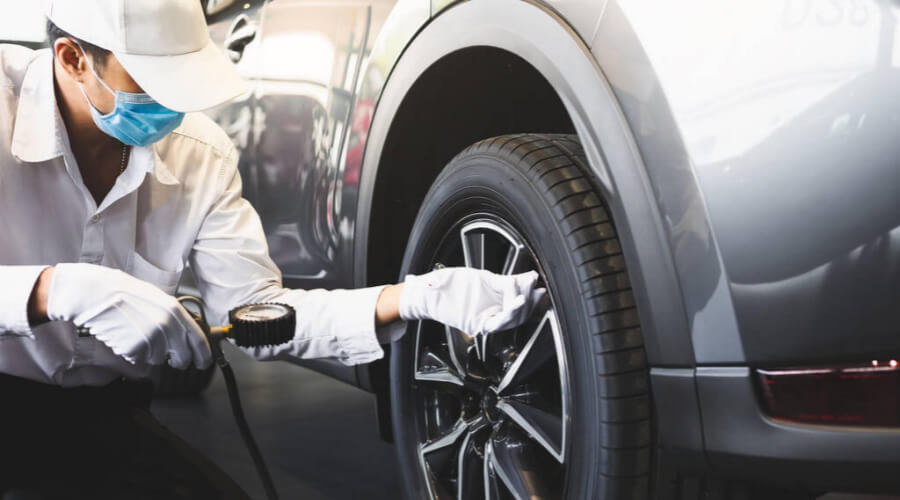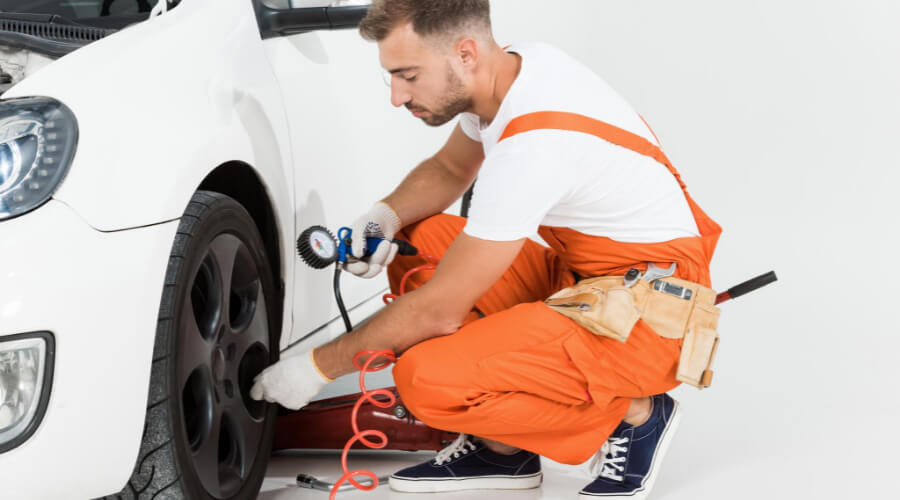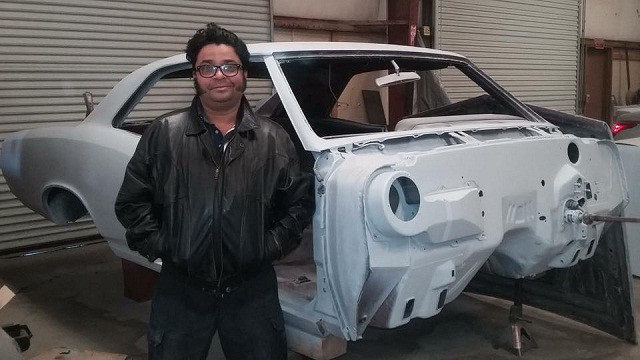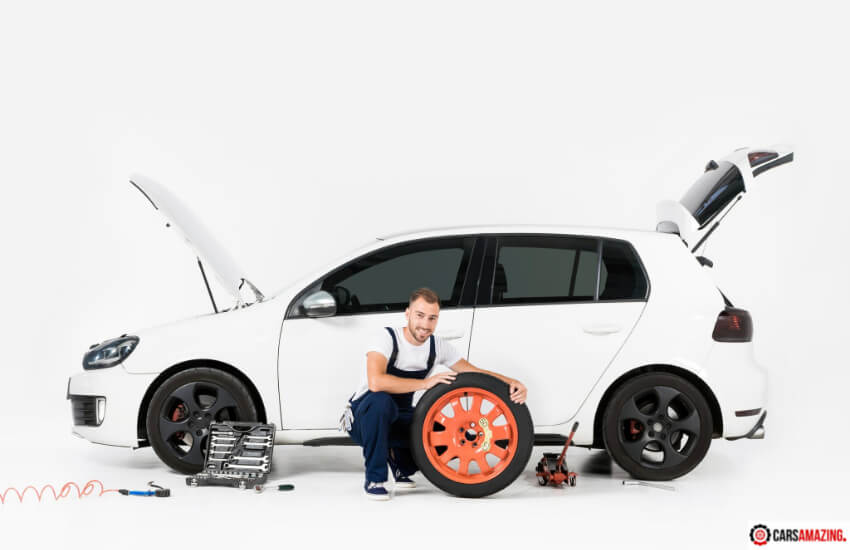Last Updated on December 24, 2022 by Leepu Da Maxim
The tire pressure for Ford Focus lies between 32psi to 46psi, as indicated by the manufacturer. However, what will be the perfect tire pressure for your Ford Focus depends on quite a few factors like the model, year of the vehicle, the gross vehicle weight rating (GVWR), type of tire, size of tires, etc.
Key Takeaways
- The appropriate tire pressure is required for the safety, performance, responsiveness, and traction of a Ford Fusion
- According to many professionals, you should at least check the pressure of the tires twice a month
- You will need a tire pressure gauge to check the pressure of the tires
- You can install Tire Pressure Monitor on your vehicle and it will indicate when you should inflate your tires
How To Check the Tire Pressure of Ford Focus?
Checking the tire pressure of the Ford Focus is not that difficult. You will need a tire pressure gauge and a tire inflator to check the tire pressure. Now follow the below steps –
- First, you have to locate the tire pressure recommendations for your vehicle
- You should check the pressure of the tires when the tire is cold because if the tire is hot then it will increase the pressure
- Now, remove the valve cap from the tire you want to check
- Next, insert the tire pressure gauge onto the valve stem
- You will see the current tire pressure on the pressure gauge
- Finally, compare the tire pressure to the recommended pressure for your vehicle stated on the owner’s manual
Ford Focus Tire Pressure Based on Year Model

According to tirepressure.com, Ford Focus tire pressure should be as shown in the table below:
Ford Focus 2018 Tire Pressure
| Tire Size | Front Tire Pressure | Rear Tire Pressure |
| 195/65R15 91H | 35psi | 35psi |
| 215/50R1791H | 35psi | 35psi |
| 215/50R17/XL 95W | 35psi | 35psi35psi |
| 215/55R16 93H | 35psi | 35psi |
| 235/35R19/XL 91 (Y) | 46psi | 46psi |
| 235/40R18/XL 95Y | 36-39psi | 36-39psi |
| P225/50R17 93V | 38psi | 38psi |
Ford Focus 2017 Tire Pressure
| Tire Size | Front Tire Pressure | Rear Tire Pressure |
| 195/65R15 91H | 35psi | 35psi |
| 215/50R1791H | 35psi | 35psi |
| 215/50R17/XL 95W | 35psi | 35psi35psi |
| 215/55R16 93H | 35psi | 35psi |
| 235/35R19/XL 91 (Y) | 46psi | 46psi |
| 235/40R18/XL 95Y | 36-39psi | 36-39psi |
| P225/50R17 93V | 38psi | 38psi |
Ford Focus 2016 Tire Pressure
| Tire Size | Front Tire Pressure | Rear Tire Pressure |
| 195/65R15 91H | 35psi | 35psi |
| 215/50R1791H | 35psi | 35psi |
| 215/50R17/XL 95W | 35psi | 35psi35psi |
| 215/55R16 93H | 35psi | 35psi |
| 235/35R19/XL 91 (Y) | 46psi | 46psi |
| 235/40R18/XL 95Y | 36-39psi | 36-39psi |
| P225/50R17 93V | 38psi | 38psi |
What Is ‘Original Equipment’ Tire?
Original Equipment tire (OE) is the tire originally put in your car at the factory. While selecting these tires, the automakers collude with tire manufacturers to identify or develop tires that suit the characteristics and purposes of your car. For example, the manufacturer will choose a tire with a luxurious and quiet ride for a luxury vehicle.
For a hybrid, they will select an eco-friendly low rolling-resistance tire. They will select a tire with better handling and general performance for a sports car. In some instances, tire manufacturers develop and test customized versions of their tires or launch new tires to meet the applications of a particular OE.
Several OE tires are available for a particular vehicle; for instance, if you are driving a 2013 Honda Accord Sedan, depending on the style you drive, it could be fixed with a range of tires from different brands.
What Is The Importance Of Proper Tire Inflation?

Keeping your tire inflated at the recommended pressure by the manufacturer is vital to the maintenance of your vehicle and tires. If you don’t follow the recommended instructions, you may get various risks. Low tire pressure influences braking distances and becomes unresponsive during steering and handling.
This can be particularly risky when an emergency brake is needed or during a sudden evasive move to avoid a collision. Also, low pressure causes the tire sidewalls to bend too much, releasing heat. While moderate heat increases tire tread wear, excessive heat can lead to loss of tread segments and blowouts.
Under-inflated tires have better rolling resistance, which minimizes fuel economy. They also wear quickly at the edges of the tread, which means you need to replace them sooner than with properly inflated tires.
Overly inflated tires do have not many problems. Modern tires can work well with pressures that exceed those recommended for usual driving. Nevertheless, frequently overinflated tires offer a less compliant ride and experience more rapid wear in the center of the tread, indicating that you should do a replacement sooner than properly inflated tires.
What are the Pros of Original Equipment Tires?
After using your car, you will inevitably need to replace your Original Equipment tires after some time. They can last up to 50,000 miles but begin to wear at 30,000 miles. Despite the apparent lack of durability from these tires, there is no good reason why you should dish out your cash for their high-quality tires. Depending on the brand, a modified set of tires will improve your car’s handling traction and promote safety. However, for car enthusiasts, buying a replacement set of Original Equipment tires could give the following advantages:
- They Are Good at Everything
Before being shipped off, Original Equipment tires have to go through various tests. The tests have to prove that the tires can drive through different conditions such as cold, snow, dry road, gravel, and pavement.
These tires could therefore be regarded as a jack of all trades. If you are a driver who needs your tires to take you from one point to another and perform well in various conditions, then OE tires are appropriate for you.
- They Are Designed Purposely for Your Car
These tires were not just picked at the back of a warehouse and fixed in your new car. In addition, OE tires are not similar across the board; they can also differ among a particular brand’s different styles or trims.
The automakers mainly made the tires to meet your specific car’s features. For instance, a Hybrid’s OE tires are remarkably different from Jeep’s EO tires. Manufacturers chose these tires to maximize your car’s performance. Otherwise, you might find yourself disappointed with aftermarket replacement tires, especially if the design doesn’t suit your vehicle.
Why Does the Tire Pressure Light Turn On in My Ford Focus?
1. Change Of Temperature Outside
If you reside in an area characterized by a cold climate, keep tire temperature outside the house in the morning. When the temperature is higher, this could lead to excessive air entering the tire for driving throughout the day.
This explains why the temperature light turns on when the outside temperature declines. Because air density fluctuates according to temperature, the tire pressure warning may turn on since it is affected by cooler temperatures.
2. Recent Change Of Rotation Of The Tire
If the tire position is altered, the tire sensors may need resetting. This may mean you should drive around for some minutes to allow the sensor to reset depending on the vehicle. If this doesn’t work, you may need to visit a dealership for proper calibration.
3. Damaged TPMS Sensors
The sensors on the TPMS may become damaged as time goes by because of the car’s travels over tough bumps or during tire servicing. Over time, the onboard battery also gets damaged. It might get damaged if the physical tire is ruined or filled with anything apart from air or nitrogen.
4. Faulty Wheel Speed Sensors
The wheel speed sensors on the TPMS Indirect system may get spoiled hence sending the wrong signal.
5. Low Pressure In Spare Tire
If the tire pressure warning light begins to illuminate the moment you use the spare tire, it indicates it also has low pressure.
What If The Light Is Still On After Adding Air To My Ford Focus Tire?
The first thing to do is use a tire pressure gauge to get a second reading to ensure the air pressure is appropriate. If the light on the dashboard remains on for a long, it means one or more of the tires are leaking air. If the light brinks on for one second and then off for three seconds severally, this shows the car has problems with one or more of the sensors. Contact the dealer immediately for service.
Reference:
https://www.focusst.org/threads/tire-pressure-for-comfortable-ride.34131/
https://www.focusfanatics.com/threads/tire-pressure.268378/

Hi, I’m Leepu Da Maxim , a dedicated car enthusiast with over 10 years of experience in this field, and I’m thrilled to share my passion and expertise with fellow car enthusiasts like you. My journey began in my hometown West Jordan, Utah, where my fascination with the mechanics and design of cars sparked at a young age. Over the years, this passion has evolved into a commitment to providing accurate, insightful, and engaging information about all things automotive through CarsAmazing .

